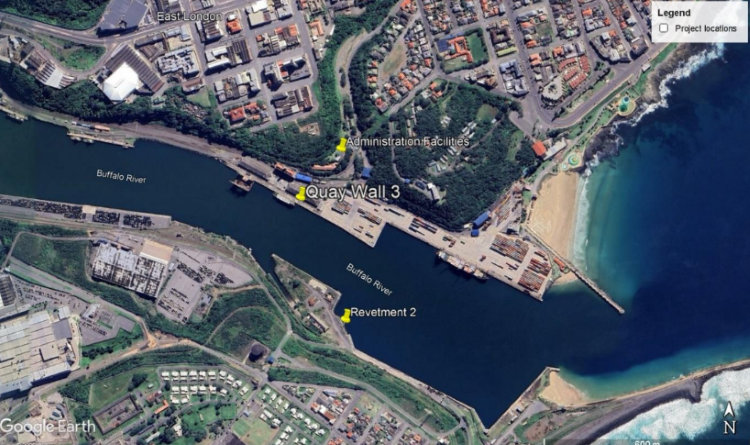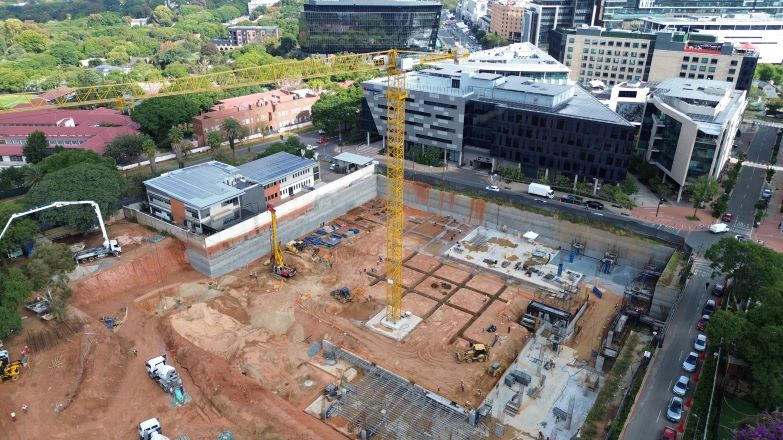
As part of the proposed rehabilitation of the century-old Quay Wall 3 at the Port of East London, SRK Consulting has completed a geotechnical investigation to assess ground conditions at the site.
Extensive upgrades are planned for the quay and other port infrastructure by Transnet National Ports Authority (TNPA). The Port of East London is South Africa’s only river port, situated at the mouth of the Buffalo River in the Eastern Cape. In addition to being an export hub for the region’s automotive sector, the port also handles key commodities such a dry bulk grains, livestock and processed foods.
Appointed by Geomech Africa (the contractor), SRK prepared the interpretive report on the borehole cores and test pits, according to Brent Cock, principal engineering geologist at SRK Consulting.
“The report was based on marine-based and land-based vertical rotary core drilling – as well as test pits – completed by the contractor,” said Cock. The fieldwork phase of the project involved drilling four marine-based drill holes to a depth ranging from 10 m and 16 m below the river bed, and four land-based drill holes below the quay wall platform – terminating at a depth ranging from 17,5 m to 20 m below the platform surface.
Dynamic Probe Super Heavy (DPSH) tests were also conducted from the river bed level and from below the quay wall platform. Three test pits were hand-excavated to depths of up to a metre deep, below the quay wall concrete platform surface to expose the underlying layer works.
“SRK logged the borehole cores and profiled the test pits, identifying and demarcating representative soil and rock samples for testing,” he explained. “After specifying which tests were to be carried out on the samples including a review of the results, we prepared the geotechnical investigation interpretive report.”
Tests were conducted on the upper and lower horizons of the layerworks, as well as on rockfill and marine sand. Among the variables tested were the particle size distribution, shear strength and compressibility of the soil horizons and compressive strength of the bedrock. The investigation also evaluated the excavation conditions that were likely to be encountered on the site, in terms of the SANS 1200D standard.
The current quay wall consists of a mass concrete gravity structure founded on a mass concrete foundation cast either within marine sand or directly on the underlying bedrock. The proposed new quay wall is planned for construction four metres in front of the existing wall.
“Being a busy port, the work had to be carried out within a live environment with due regard to strict health and safety protocols, taking into account the movement of shipping, all completed by the contractor without incident and to a very high standard,” he said.
Cock highlighted that the information gathered, and recommendations derived from a geotechnical study are important to assist the design engineer in designing a safe and cost effective foundation solution for the structure. The findings of this geotechnical report will inform the final design of East London harbour’s new quay wall, providing vital data to confirm the preliminary design assumptions.
More news
- CELEBRATING EXCELLENCE IN THE RESIDENTIAL PROPERTY SECTOR
- PART 4: GIBS PANEL DISCUSSES INTEMEDIATE CITIES ROLE IN AFRICA’S DEVELOPMENT
- EXPOSED AGGREGATE PAVERS COMPLEMENT NEW LIFESTYLE CENTRE
- GIBS PANEL EXPLORES ROLE OF INTERMEDIATE CITIES IN SA’S DEVELOPMENT PART 3
- CITI-CON’S CONCRETE KNOWLEDGE SUCCESSFULLY DEPLOYED ON NEW LANDMARK DEVELOPMENT





